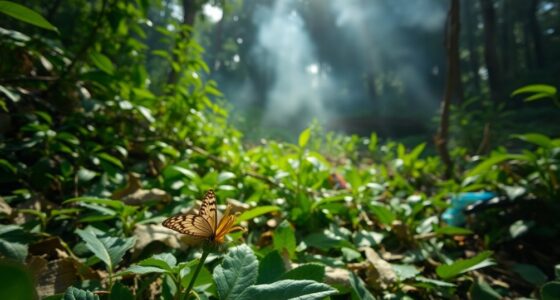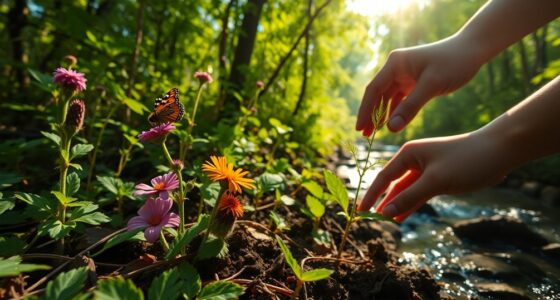Plastic pollution has become one of the most pressing environmental issues of our time, affecting wildlife, ecosystems, and human health. Despite decades of awareness, the problem continues to grow, driven by our reliance on single-use plastics and insufficient waste management. Understanding how we got here and what can be done is crucial if we want to turn the tide. The solutions might be within reach, but only if we confront the challenge together.
The Origins and Escalation of Plastic Pollution
Plastic pollution originated with the widespread use of plastics in the mid-20th century, as manufacturers found inexpensive ways to produce durable materials for everyday items. Suddenly, single-use plastics like bottles, bags, and packaging became common, making life more convenient. You mightn’t realize it, but these products often ended up in landfills or the environment after just one use. As production increased, so did plastic waste, overwhelming waste management systems worldwide. The global economy fueled this growth, with cheap plastics flooding markets and consumers. Over time, the durability of plastics meant they persisted in nature for hundreds of years, accumulating in oceans, rivers, and landscapes. This escalation marked the beginning of a serious environmental challenge that continues today, driven in part by the durability of plastics.
The Environmental Impact of Plastic Waste
Because plastic waste accumulates in ecosystems, it poses serious threats to wildlife, human health, and the environment. Animals often mistake plastic debris for food, leading to injury, starvation, or death. The pollution of ecosystems further exacerbates the decline of biodiversity and disrupts natural habitats. Marine life, in particular, suffers from entanglement and ingestion of plastics, disrupting entire food chains. Plastics also release toxic chemicals as they degrade, contaminating water sources and entering the food supply. Landfills overflow with non-biodegradable waste, leaching harmful substances into soil and groundwater. The persistent nature of plastics means their impact lasts for hundreds of years, slowly harming ecosystems and reducing biodiversity. Human communities face increased health risks from polluted water and food sources tainted with microplastics. Overall, plastic waste significantly degrades environmental quality and threatens the planet’s delicate balance.
Innovative Solutions and Technologies to Combat Plastic Pollution
As awareness of plastic pollution grows, innovative solutions and advanced technologies are emerging to address this urgent problem. You can now find biodegradable plastics made from plant-based materials that break down faster than traditional types, reducing landfill accumulation. Additionally, efforts are underway to develop safer and more effective sunscreen formulations for sensitive skin, including those suitable for newborns. Researchers are developing chemical recycling methods that convert plastics back into raw materials, enabling true circularity. Floating barriers and cleanup devices, like the Ocean Cleanup project, actively remove plastic debris from oceans and rivers. Additionally, AI-powered sorting systems improve recycling efficiency by accurately separating plastics from other waste. New materials, such as edible packaging, aim to replace single-use plastics altogether. These technological advances hold promise, but their success depends on widespread adoption and integration into existing waste management systems.
Community-Led Initiatives and Grassroots Movements
Community-led initiatives and grassroots movements are playing a vital role in tackling plastic pollution by mobilizing local efforts and raising awareness at the ground level. You might join beach cleanups, organize recycling drives, or educate neighbors about reducing plastic use.
These grassroots efforts foster a sense of collective responsibility and empower communities to take action. Local groups often identify specific issues unique to their area, allowing for targeted solutions that larger policies may overlook. Incorporating community participation enhances the effectiveness of these initiatives and ensures sustainable impact.
By sharing success stories and practical tips, you help build momentum and inspire others to participate. Your involvement creates a ripple effect, demonstrating that small, consistent actions can lead to significant change.
Ultimately, these initiatives strengthen community bonds and drive sustainable habits that combat plastic pollution locally and globally.
Policies and Global Agreements to Reduce Plastic Use
Efforts to reduce plastic use on a global scale are driven by a series of policies and international agreements aimed at limiting plastic production, encouraging recycling, and preventing waste from reaching our oceans and ecosystems. Countries have adopted bans on single-use plastics, such as bags and straws, to curb unnecessary waste.
Global initiatives like the Marine Debris Pact foster cooperation among nations to address plastic pollution in oceans. The Basel Convention now regulates plastic waste shipments, preventing illegal dumping.
Many nations are setting ambitious recycling targets and phasing out problematic plastics. These policies aim to create a unified response, reduce plastic production, and promote sustainable consumption.
International cooperation plays a vital role in coordinating efforts across borders to effectively combat plastic pollution.
While progress varies, international agreements demonstrate a shared commitment to tackling plastic pollution at its source.
How Individuals Can Make a Difference
Have you ever wondered how much difference one person can make in fighting plastic pollution? The truth is, your choices add up.
You can start by reducing single-use plastics like bottles, straws, and bags. Opt for reusable alternatives whenever possible. Be mindful of packaging — buy in bulk or choose products with minimal wrapping.
Properly recycle plastics to prevent contamination and support local recycling programs. Spread awareness by talking to friends and family about plastic pollution’s impact.
Participate in local cleanup events or join community initiatives. Small actions, when multiplied across many people, create significant change. Incorporating sustainable practices into your daily routine can also enhance your impact and promote a healthier planet.
Conclusion
You have the power to make a difference in the fight against plastic pollution. By reducing single-use plastics, supporting innovative solutions, and staying informed, you can help protect our planet. Every small action counts, whether it’s recycling, choosing eco-friendly products, or advocating for stronger policies. Together, your efforts contribute to a cleaner, healthier Earth for future generations. Join the global movement and be part of the solution to create a plastic-free planet.




